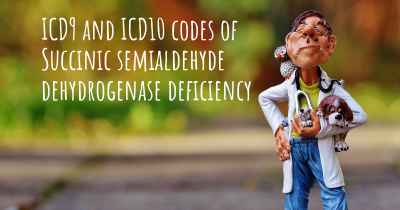Is Succinic semialdehyde dehydrogenase deficiency hereditary?
Here you can see if Succinic semialdehyde dehydrogenase deficiency can be hereditary. Do you have any genetic components? Does any member of your family have Succinic semialdehyde dehydrogenase deficiency or may be more predisposed to developing the condition?

Succinic semialdehyde dehydrogenase deficiency is a hereditary condition. It is caused by mutations in the ALDH5A1 gene, which is passed down from parents to their children. This genetic disorder affects the body's ability to break down a neurotransmitter called gamma-aminobutyric acid (GABA). Individuals with this deficiency may experience developmental delays, seizures, and other neurological symptoms. Genetic counseling is recommended for families with a history of this condition.
Is Succinic semialdehyde dehydrogenase deficiency hereditary?
Succinic semialdehyde dehydrogenase deficiency (SSADH deficiency) is a rare genetic disorder that affects the metabolism of a neurotransmitter called gamma-aminobutyric acid (GABA). GABA is an important inhibitory neurotransmitter in the central nervous system, and its dysregulation can lead to various neurological symptoms.
Genetic Basis of SSADH Deficiency
SSADH deficiency is caused by mutations in the ALDH5A1 gene, which provides instructions for producing the enzyme succinic semialdehyde dehydrogenase. This enzyme is responsible for the final step in the breakdown of GABA, converting succinic semialdehyde into succinic acid. Mutations in the ALDH5A1 gene result in reduced or absent enzyme activity, leading to the accumulation of succinic semialdehyde and GABA in the body.
Inheritance Pattern
SSADH deficiency follows an autosomal recessive inheritance pattern. This means that an individual must inherit two copies of the mutated ALDH5A1 gene, one from each parent, to develop the disorder. If both parents are carriers of a single mutated gene, they have a 25% chance of having an affected child with SSADH deficiency, a 50% chance of having unaffected carrier offspring, and a 25% chance of having an unaffected, non-carrier child.
Carrier Status
Carriers of a single mutated ALDH5A1 gene are generally asymptomatic and do not show any signs or symptoms of SSADH deficiency. However, they can pass on the mutated gene to their children. If both parents are carriers, there is a 25% chance with each pregnancy that their child will inherit two copies of the mutated gene and develop SSADH deficiency.
Prevalence
SSADH deficiency is an extremely rare disorder, with an estimated prevalence of 1 in 250,000 to 1 in 1,000,000 individuals worldwide. Due to its rarity, it may often go undiagnosed or misdiagnosed.
Symptoms and Clinical Presentation
The symptoms of SSADH deficiency can vary widely among affected individuals. Some common symptoms include developmental delay, intellectual disability, speech and language impairments, hypotonia (low muscle tone), ataxia (lack of muscle coordination), seizures, and behavioral problems. The age of onset and severity of symptoms can also vary, even among individuals within the same family.
Diagnosis and Genetic Testing
Diagnosing SSADH deficiency involves a combination of clinical evaluation, biochemical testing, and genetic testing. Biochemical testing can detect elevated levels of succinic semialdehyde and GABA in urine, while genetic testing can identify mutations in the ALDH5A1 gene. Genetic counseling is recommended for individuals and families affected by SSADH deficiency to understand the inheritance pattern and the risk of passing on the condition to future generations.
Treatment and Management
Currently, there is no cure for SSADH deficiency. Treatment mainly focuses on managing the symptoms and improving the quality of life for affected individuals. This may involve a multidisciplinary approach, including physical therapy, speech therapy, occupational therapy, and educational support. Medications such as vigabatrin, which increases GABA levels in the brain, may be prescribed to help control seizures and improve neurological symptoms.
Conclusion
Succinic semialdehyde dehydrogenase deficiency is a hereditary disorder caused by mutations in the ALDH5A1 gene. It follows an autosomal recessive inheritance pattern and is characterized by the accumulation of succinic semialdehyde and GABA in the body. Genetic testing and counseling are essential for individuals and families affected by SSADH deficiency to understand the risks and make informed decisions. Ongoing research aims to improve our understanding of the disorder and develop potential therapies to alleviate its symptoms.








